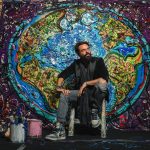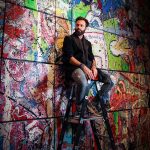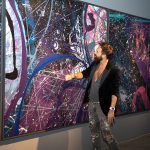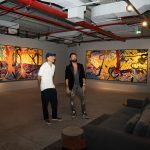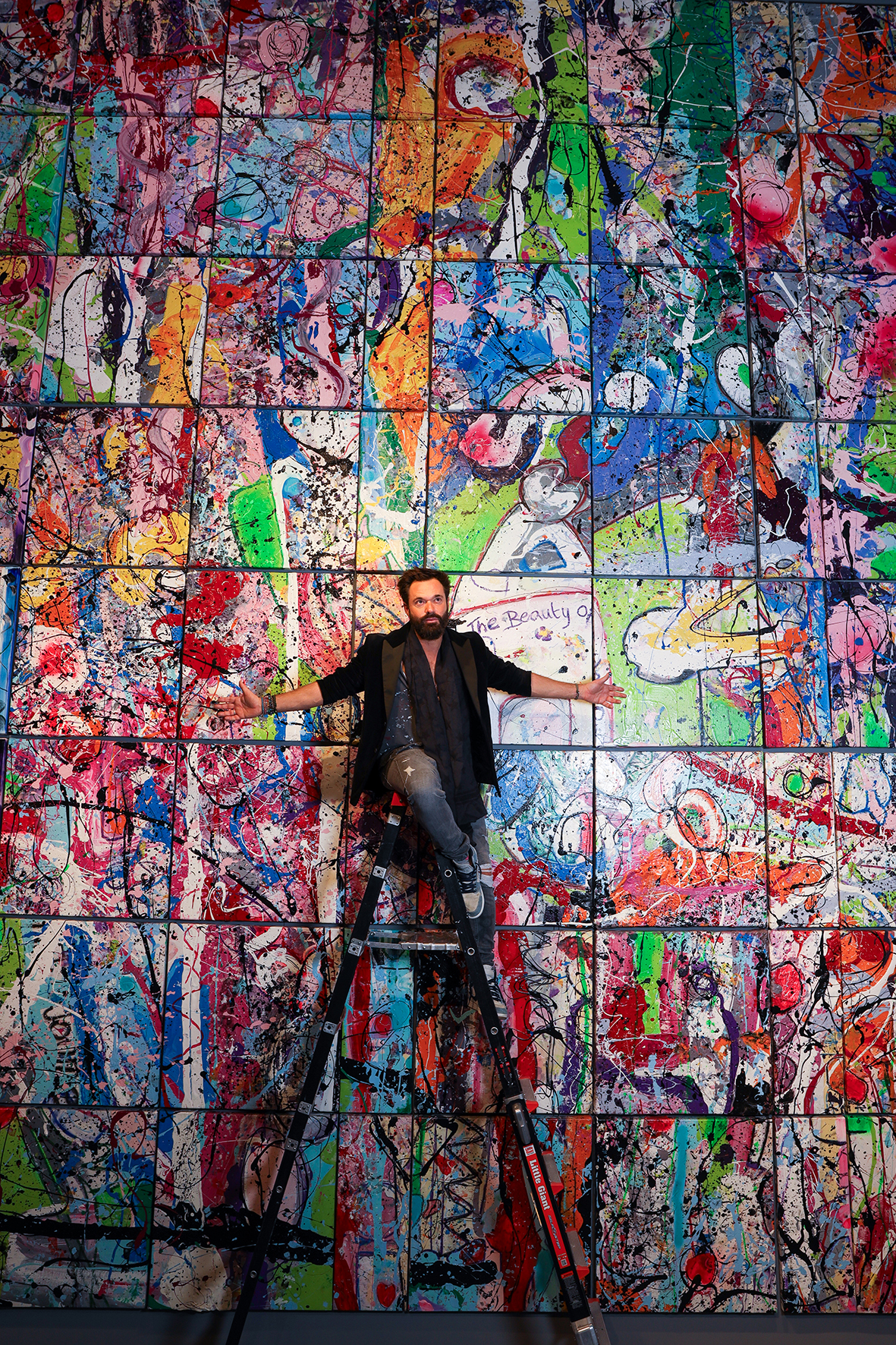
Your work connects deeply on an emotional and universal level. What’s going through your mind when you start a new piece?
Surprisingly, nothing. I paint from a deep meditative state, almost like a trance. Studies on my brainwaves revealed I enter a Theta state of surrender, which is rare for artists. This state allows me to focus on pure intentions rather than the final outcome. I believe that humans communicate most powerfully through energy, and the energy we emit is shaped by our intentions. When our intentions are pure, the vibrations we create can truly connect with others on a soulful level.
When I start a painting, I focus on one singular emotion, which manifests as a ball of color in my mind. From there, shapes, marks, and a narrative evolve. This process is emotionally exhausting but incredibly powerful as it draws out the raw essence of the human soul.
How did you first get into art?
My journey began in childhood. I have synaesthesia, a condition where my senses are mixed—I hear colour and see sound. This made life challenging, especially with severe dyslexia, but painting became my way of making sense of the world.
I started painting seriously around the age of seven. Unlike most children, I could focus on painting for hours. It gave me peace, clarity, and a way to process the overwhelming energy and emotions I felt from the world around me. Painting remains essential for my well-being; if I don’t paint for a while, I become restless and difficult.
Themes like unity, love, and humanity are central to your work. Why do these ideas matter so much?
I believe we communicate through energy at our purest form, but this requires surrendering ego and connecting to something greater than ourselves. Today, we’re surrounded by static energy—caused by questionable intentions like greed or ego—which disrupts our ability to connect meaningfully.
Through my art, I aim to slow people down, inspire introspection, and encourage a return to purity of intention. Humanity’s future lies not in technology but in understanding ourselves, our bodies, and nature. The human body is the greatest technology on Earth, with an unmatched ability to surrender and connect. If we can refocus on this, we can create profound change.
Do you think AI will ever be able to create art like yours?
Sacha: No, and here’s why: true art comes from surrender and pure intention, which AI cannot achieve. AI relies on data from the past and can’t connect to something greater than itself. While AI is incredibly useful in fields like healthcare, education, and design, it cannot replicate the vibrations and frequencies that come from human creation.
Real art has an emotional impact because it carries the energy of its creator—something no machine can emulate. It’s this ability to surrender and connect that makes us uniquely human and capable of creating meaningful art is feel it. The essence of my work isn’t about intellectual analysis; it’s about emotional connection. You’re meant to stand before it and let the energy of the piece flow into you, evoke something within you—memories, emotions, or even just a sense of peace or chaos. The point is not to think but to feel.
Over the years, my style has evolved significantly because my work reflects my journey—my personal growth, my emotions, and the lessons I’ve learned. In the beginning, I was much more focused on the technical aspects of painting—perfecting forms, experimenting with techniques, and playing with traditional mediums. But as I grew, I started letting go of perfection and control. I embraced spontaneity, rawness, and the power of surrender, which we spoke about earlier.
The biggest shifts in my style often come from life-changing experiences—loss, love, or even just moments of profound clarity. These moments push me to explore new textures, colors, or techniques. For example, I went through a phase where I worked heavily with gold leaf and encaustic techniques because I was fascinated by the interplay of permanence and decay—how beauty can exist in both.
Now, my work is more about energy and vibration. I use bold, dynamic movements to transfer my own energy onto the canvas, and I experiment with unconventional materials. I’m constantly inspired by nature, humanity, and the invisible threads that connect us all. So, while my style continues to evolve, the underlying intention remains the same: to create pieces that resonate deeply with the soul of the viewer.
Well, art has this amazing way of connecting cultures. Definitely. How do you think art can help build understanding between the West and the Middle East?
I think it’s not about the West and the Middle East. Did you say the West and the Middle East? Yes. I don’t think it’s about the West and the Middle East. I don’t believe the world or humanity should be divided into East, West, North, or South. What we need to understand is that we should not focus on our differences, but on our similarities.
In simple terms, we are all made of the same thing. No matter our color, creed, or religion, we are made of the same scientific makeup, same atoms, same molecules—we are all the same. We are one. That’s a simple fact. Some people may act as if we are not one, but that’s irrelevant; we are one.
I think art can help us understand this, but really, we don’t need to “connect” as one because we already are one. We need to recognize that fact. And art can aid in that understanding. The power of art lies in the intention behind its creation. When you create art, the most important thing is to focus on your intentions.
As an artist, you must get into a state of surrender and connect with something more powerful than you. When you’re in that state, it’s not about what you make but how you live your life. Focus on living a life of grace, goodness, compassion, empathy, love, and intention. If you live with these qualities, then occasionally, you will borrow a moment of inspiration. But remember, it’s just a moment—you didn’t create it, you borrowed it. You must give it back and say thank you.
If you forget that it’s a borrowed moment and let your ego take over, thinking, “Look what I did,” that moment won’t come again. People call this “creator’s block,” but there’s no such thing. It’s simply when you stop living a life of grace and you let your ego interfere. The more you do this, the more those moments of creativity will continue to flow.
I believe that’s the most important thing to realize about the power of art and its ability to reconnect us. It’s not about how great we think we are—it’s about understanding that we are all connected.
Saudi Arabia is really becoming a hub for art and culture. What do you think of the Kingdom Vision 2030? Do you see yourself being part of the art scene there?
What Saudi Arabia has achieved in the last five years is phenomenal, and their Vision 2030 is even more remarkable. Most countries, especially in Europe, might give you a vision for the future and only achieve a fraction of it. But Saudi Arabia has the potential to achieve 90% of it, which is extraordinary. Even if they achieve only 60%, it would still be one of the most impressive feats humanity has ever seen.
Believe it or not, many aspects of Vision 2030 are already 90% achieved. But there is still more to do, and much of it revolves around sustainable goals and broader achievements. Their intentions are incredible, and I believe they will reach them. I see myself as part of that, particularly within the arts.
There’s a humility among the leadership, especially figures like Prince Badr Al-Saud, who, along with other key figures, have a clear vision for the country. They understand the importance of education and cultural development, and Saudi women are playing an important role in shaping this future. The Saudi arts scene is a huge part of that vision, and it will only continue to grow.
That being said, there is a danger in how art is presented. Art needs to be created with intention and placed in the world in the right way. Too much art today is created and exhibited without understanding its deeper purpose. When art is placed in the world with the wrong intention, it can contribute to the disconnection from humanity and the planet. We must not become obsessed with technology; the future of humanity lies in reconnecting with each other and with nature.
So, for Saudi Arabia to achieve its cultural vision, they must continue to ensure that art is created with high vibration and intentionality. If they do this, the arts will thrive and truly help reconnect us as humans. I’m excited to see what the future holds.
Saudi Arabia has one of the youngest populations in the world, along with Nigeria. How do you think art can inspire young people in Saudi Arabia and across the region?
Art can inspire young people immensely. I’ve touched on this throughout our discussion. I’ve been to Saudi Arabia many times, visiting Jeddah and Riyadh, where I’ve worked on charitable projects. What’s being done in AlUla, Jeddah, and Riyadh is absolutely stunning, and I see myself being part of the Saudi art scene, sharing my creations with the people there.
Young people can definitely be inspired by art—if it is created with intention. Art can question, inspire, and provoke thought. However, the biggest issue today is the obsession with instant gratification. Our world is obsessed with instant connections, quick rewards, and instant feedback. If young people don’t connect with something in two seconds, they move on.
Art, when placed correctly, can slow us down. We need that pause. It helps us to look inward, to question who we are, where we’re going, and our connection to something greater than ourselves—whether we call it God, Allah, or any other belief system. Art can help us reconnect with that deeper truth. It has the power to do so, and that’s a very powerful thing.
Speaking of luxury brands, you did a special project with Rolls-Royce that blends luxury with art. How did that partnership happen and what was the experience like for you?
That was an incredible project. Rolls-Royce is a brand I’ve always respected. Many people don’t realize they’ve been around for 148 years and were one of the first car manufacturers. They are a brand that I love, not just because of their history but because they constantly evolve. They’re so powerful that the term “Rolls-Royce” is now used to describe the best of anything—it’s not just a brand, it’s a word in the vocabulary.
Their evolution in the last ten years, especially post-COVID, has been impressive. The Rolls-Royce buyer has changed. Where it was once aimed at people in their 50s and 60s, now it’s attracting a younger clientele, in their mid-20s to mid-30s. Rolls-Royce adapted without losing the essence of their brand, which is no easy feat.
The partnership came about when Rolls-Royce approached me with the idea of collaborating. It became the first co-branded Rolls-Royce collection in the company’s 148-year history, and I had the honour of being the first artist to collaborate with them. I created a collection of six Rolls-Royces based on elements of nature: Earth, Wind, Water, Fire, and Humanity. Each painting I created inspired a specific car in the collection, with the final result being a stunning collection of six bespoke cars.
The process was amazing. I worked closely with their Goodwood headquarters to create these cars. Most people can modify a Rolls-Royce, but Goodwood will never send a car out unless it meets their exact standards. The fact that they allowed me to create a unique collection of six Rolls-Royces from Goodwood was unprecedented.
Each car in the collection featured a hand-painted dashboard in the Phantom II, and I used a special exterior paint that Rolls-Royce had never used before and won’t use again. It was truly a one-of-a-kind project, and I’m incredibly proud of it.
